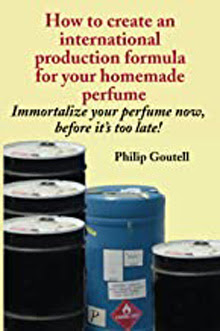
Perfume doesn't evolve from a random mixing. Developing a new perfume involves having a plan. The big companies call it a "perfume brief." If, instead of a perfume you were developing a TV commercial, you would call it a storyboard.
This description of your "perfume to be" can involve pictures, video clips, words, maps, foods, even smells and existing perfumes. What you are defining is a
goal. What you are avoiding is
random mixing -- putting aroma materials together without a plan. Randomness can be fine for experiments; to learn what happens when various aroma materials are combined and to store these impressions and formulas away in your personal memory bank. But when it comes time to develop a perfume, you want to be sure that you have a target -- an aroma goal. You'll be amazed at how much faster you learn perfumery if you direct your work toward well defined goals.
I'm on vacation in Canada and, on this vacation, I wanted to start working on a new perfume. I had some ideas that started coming to me as I worked on advertising concepts for some of
my existing fragrances. At present all this planning is still confidential but I will tell you that I sat down with a notebook and pen and started to draw pictures, imagine certain music, focus on a particular geographical area (which I've never visited!) and meditated on what aromas might appeal to a fantasy woman in that (to me) fantasy city. These images suggested to me certain aroma materials to use to get started.
As mentioned, I was on vacation at our house in Canada, traveling light. Today perfumers have access to around 3,000 aroma materials. Top perfumers sometimes limit themselves to about 200 basic aroma materials. My kit consisted of the 25 Fleuressence aroma bases that represent the 25 aroma groups -- not to be confused with perfume types -- used in the
PerfumersWorld ABC's of Perfumery teaching method. It is a bit like having a small set of oil paints, yet knowing those paints, mixed in proportions and combinations, can create an infinite range of colors.
So is it too with my kit of 25 Fleuressence bases from the
PerfumersWorld Foundation Course in Creative Perfumery.
Now I have my target and I have my materials. Now I am ready to start working on the physical creation. From the years I have worked with these 25 materials I have developed a sense of how to put them together to give me what I want. But I continue to make new discoveries too; to find desirable aromas by blending various of these 25 "paints" in ways I have not blended them before. Each time I work with them, my knowledge is expanded.
The work goes quickly. Four "paints" are blended. One is made dominant. The others modify and decorate. I have achieved my central theme. But there is another theme that must pull against it. I create that separately. Then the work of blending the two themes begins.
Some modifications suppress the central theme. Putting
too much into a perfume creates problems. The color becomes muddy. Certain of my "paints" must be cut back or eliminated entirely to
clarify the desired theme. This theme must be
reinforced rather then blobbed over. Complexity is desirable but extreme moderation is essential. The decorations should draw attention to the melody, not compete with it.
The project comes together. I have my perfume. But... BUT, at this stage, working with my 25 bases, I have only drafted the OUTLINE for the fragrance that is in my head, the fragrance that is suggested by my "perfume brief." It is as far as I will go for now.
I know, at this point, that I want to make certain
substitutions. There are effects I want to achieve that I personally do not know how to achieve with my 25 "colors."
When I return home, when I return to my many, many little bottles, I will select certain "colors" and use them as substitutions because I believe some will be more precise. I know already most of the substitutions I want to make. I will try a few experiments too, to see if some "colors" with which I am less familiar might be suitable to help me achieve the final result that I want.
It will be these final steps, these final substitutions and adjustments, that will determine whether my final result will amount to anything great or not.




